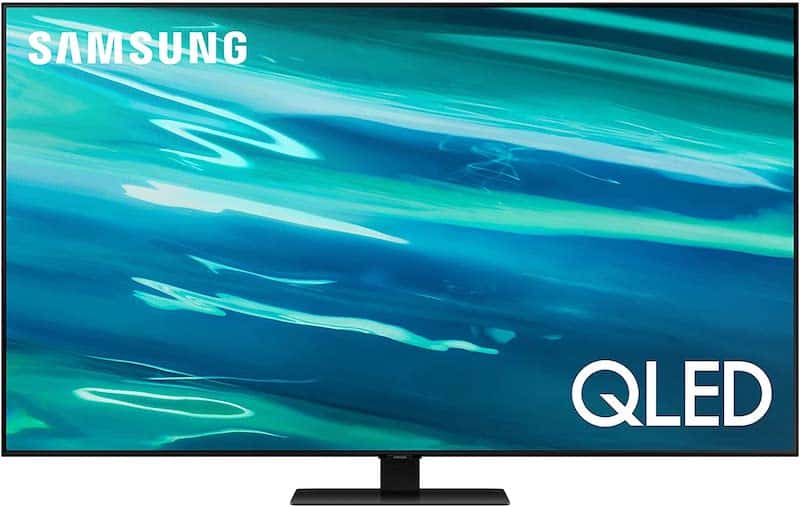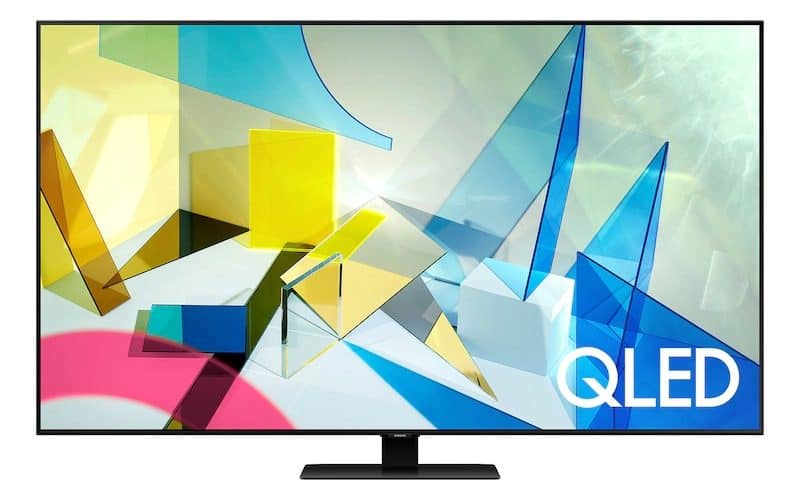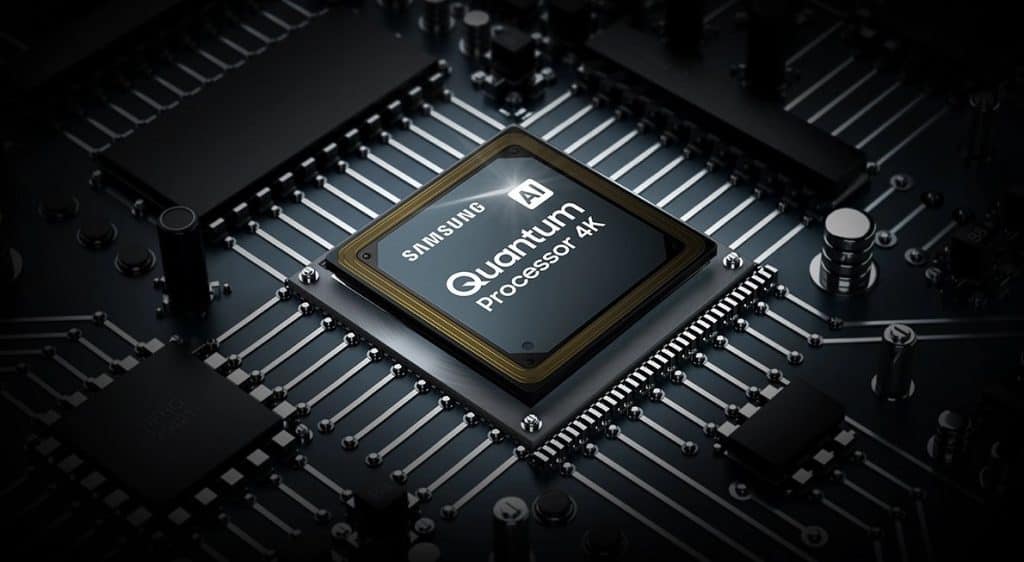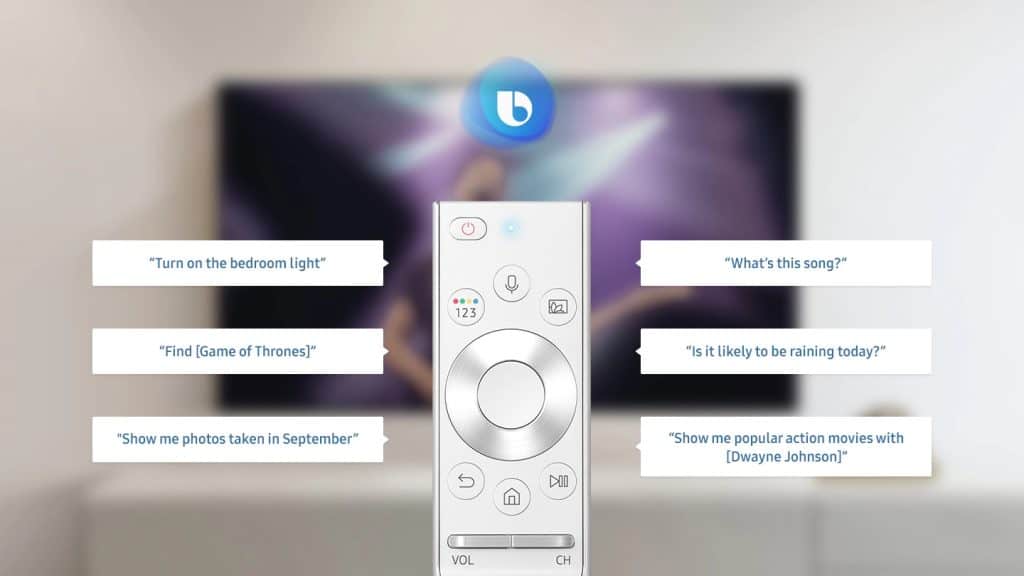Samsung reigns as the world’s largest television manufacturer since 2006. This company offers models for everyone’s taste and budget, from budget-friendly to super expensive, moderately-sized to massive 8K TVs. In this Samsung Q80A vs Q80T article, we’ll discuss two Samsung models that fall somewhere in the middle of the company’s product line price-wise.
Q80A vs Q80T – Quick Comparison
Samsung Q80A

Samsung Q80A is an excellent TV for mixed usage. It’s the ideal choice for wide seating arrangements and large rooms, as it offers wide viewing angles, first-rate peak brightness numbers, and can get very loud. Here’s a closer look at Q80A’s major advantages and disadvantages:
Pros:
- Very powerful processor
- Wide viewing angles
- Excellent Smart TV OS and voice assistant
- Superb HDR and SDR brightness
Cons:
- Low native contrast ratio
- Unimpressive local dimming feature
Samsung Q80T

The Q80T offers excellent value for money by delivering an impressive all-around TV with some very powerful features. It has a robust processor, terrific Smart TV features, and provides premium picture quality. Here are some of Q80T’s most significant pros and cons:
Pros:
- Very powerful processor
- Great native contrast ratio
- Excellent Smart TV OS and voice assistant
- Outstanding reflection handling properties
Cons:
- Mediocre sound quality
- No Dolby Vision
Features Face to Face
Panel Technology
Both TVs feature Samsung’s in-house QLED panels. Even though the Q80A and the Q80T employ the same QLED panel technology, they use different panel types. The Q80A has an LED IPS panel, while the Q80T has an LED VA panel. So, what’s the difference between VA and IPS panels?
In short, Q80T’s VA panel delivers stunning picture quality but offers noticeably narrower viewing angles than Q80A’s IPS panel. In comparison, Q80A’s IPS panel offers wider viewing angles but doesn’t handle reflections as well and doesn’t have a native contrast ratio as good as Q80T’s VA panel.
Image Processor

The Q80A and the Q80T offer identical image processing and enhancing capabilities. Both TVs use the same type of image processor, the Quantum Processor 4K. This is one of the best 4K TV processors currently on the market, as it possesses outstanding picture-enhancing capabilities.
The Quantum Processor 4K uses AI and machine learning to improve lower definition content. No matter what type of content you’re watching, this processor’s advanced algorithms optimally upscales each specific scene to deliver the best possible picture quality.
Motion Technology
The Q80A and the Q80T come with excellent motion technology and deliver great response times. Comparing the numbers, we’d give a slight edge to the Q80T, as it is a bit faster transitioning between pixels. More specifically, the Q80T can fully transition from one color to another in just around ten milliseconds. That said, the Q80A doesn’t trail far behind, as it can do so in around eleven milliseconds.
Still, this difference is negligible, as both TVs display very smooth motion with minimal blur during fast-moving scenes. However, you might notice some overshoot in certain transitions. Of course, if you’re looking for a high-end TV with near-instantaneous response times, we recommend checking out an OLED model, like a Sony A9G or LG CX.
Picture Quality
When comparing the Q80A’s and Q80T’s picture quality properties, we’re primarily thinking of the supported resolutions. In this regard, both models offer excellent coverage of all of the commonly supported resolutions. For a more detailed rundown, here’s a Q80A vs Q80T supported resolutions comparison table:
| Resolution | Samsung Q80A | Samsung Q80T |
|---|---|---|
| 4K/120Hz | Yes (Native Support) | Yes (Native Support) |
| 4K/60Hz/4:4:4 | Yes | Yes |
| 4K/60Hz | Yes | Yes |
| 1440p/120Hz | Yes (Native Support) | Yes (Native Support) |
| 1440p/60Hz | Yes (Native Support) | Yes (Force Resolution) |
| 1080p/120Hz | Yes (Native Support) | Yes (Native Support) |
| 1080p/60Hz/4:4:4 | Yes | Yes |
Contrast Ratio / Black Level
The Q80T offers a great native contrast ratio, much better than the one you’d get with the Q80A. It produces much deeper and richer blacks than the Q80A. Still, Q80T’s native contrast ratio is a bit lower than what you can typically expect from a VA panel.
In comparison, the Q80A has a relatively low native contrast ratio. This often results in blacks looking gray and washed out. Plus, although you can improve the contrast ratio on the Q80A through local dimming, the overall improvement is still less than ten percent with this feature turned on.
Local Dimming
The Q80A and the Q80T both have a local dimming feature that you can enable to increase the contrast ratio. While the Q80T offers better local dimming capabilities, the improvement between the native contrast ratio and the contrast ratio with local dimming isn’t very significant. Still, the Q80T is more capable of reducing blooming around bright objects and subtitles, as the Q80A often displays visible blooming in such situations.
Peak Brightness
Both TVs can get bright enough to fight glare in bright viewing environments. That said, the Q80A offers better SDR and HDR peak brightness numbers than the Q80T. To help you see exactly how these two models fare in this category, we’ve crafted this Q80A vs Q80T peak brightness comparison table:
| Brightness Values | Samsung Q80A | Samsung Q80T |
|---|---|---|
| Peak 10% Window SDR Brightness | ∼ 860 nits | ∼ 710 nits |
| Peak 100% Window SDR Brightness | ∼ 520 nits | ∼ 420 nits |
| Peak 10% Window HDR Brightness | ∼ 960 nits | ∼ 740 nits |
| Peak 100% Window HDR Brightness | ∼ 570 nits | ∼ 440 nits |
Color
Samsung Q80T has an excellent color gamut, and the Q80A has a very good color gamut. Both TVs have the option to enable wide color gamuts, allowing them to display HDR content in great detail.
Moreover, both models have impressive coverage of the commonly-used DCI P3 color space. That said, the Q80T offers better coverage of the wider Rec. 2020 color space.
Comparing the two models’ color volume properties, the Q80A and the Q80T display bright colors very well but sometimes struggle to display dark colors in all their richness. Overall, the Q80T offers a slightly better color gamut and color volume than the Q80A.
Viewing Angle
The Q80T has decent viewing angles, which is expected from a LED VA panel. The Ultra Viewing Angle layer does expand the viewing angles a bit, but brightness loss and gamma shift appear pretty quickly as soon as you move off-center.
In comparison, Q80A’s IPS panel allows it to deliver better viewing angles than those you can count on with the Q80T. Although it also gets darker as you move off-center, it maintains good image accuracy even at wide viewing angles. So, if you’re looking for a TV for a wide seating arrangement, the Q80A is a much better choice.
Reflections / Anti-glare
When it comes to reflection handling capabilities, the Q80T heavily outperforms the Q80A. This is because the Q80T comes with a glossy screen finish, while the Q80A has a semi-gloss display finish.
To be more precise, the Q80T reflects just over one percent of total reflections. In comparison, the Q80A reflects a bit over five percent. With this in mind, the Q80T is the better choice for rooms with a lot of light, as the Q80A may struggle in brighter environments.
Sound Quality
While the Q80A and the Q80T offer equally decent sound quality, their audio properties are a bit disappointing for two models that cost as much as these two TVs. Both TVs have a reasonably well-balanced sound profile and can get very loud. Nevertheless, the bass leaves more to be desired, as it doesn’t produce significant rumble or power. They also have a few advanced audio features, most notably the digital room correction feature.
The two TVs also have okay distortion performance, although they do produce quite a bit of distortion at higher volume levels. Overall, while their audio properties aren’t underwhelming, we still recommend pairing up your new Q80A or Q80T with a top-quality Samsung soundbar for a better audio experience.
Smart TV Platform (Operating System)
As both models use Samsung’s Tizen platform, they have very similar OS capabilities. Tizen OS is one of the best Smart TV platforms in the industry. It’s a super-fast and very intuitive operating system.
That said, looking into the minute OS differences between these two TVs, the Q80A is a slightly better performer in this category. This is because it uses the 2021 Tizen OS version, while the Q80T uses the 2020 version.
Still, the differences are negligible, as the two TVs share much more similarities in this regard. Both Tizen versions offer many advanced settings and support a great selection of apps through Samsung’s app store.
Connectivity
Premium-priced TVs from a well-known brand such as Samsung should excel in all fields and deliver the best possible user experience. They also need to have strong connectivity properties for this to be true. With this in mind, the Q80A and the Q80T offer great connectivity support in the following three key connectivity aspects:
Inputs
Most Samsung TVs offer very similar input support features. This is especially true for premium Samsung models in a similar price range. In the context of this Samsung Q80A vs Q80T comparison, the two TVs offer identical physical input characteristics. To see what this includes, check out the Q80A vs Q80T input table below:
| Input Ports | Samsung Q80A | Samsung Q80T |
|---|---|---|
| HDMI Ports | 4 HDMI 2.0 Ports | 4 HDMI 2.0 Ports |
| USB Ports | 2 USB 2.0 Ports | 2 USB 2.0 Ports |
| Digital Optical Audio Out | 1 Port | 1 Port |
| Ethernet Port | Yes | Yes |
Besides the physical input characteristics, we should also mention that the Q80A and the Q80T offer impressive input lag times. Both TVs deliver input lag numbers under ten milliseconds across all supported resolutions. This makes them great for console gamers or players looking for a high-performing TV for gaming.
Voice Assistants

The two TVs use very similar remotes and the same Samsung SmartThings remote app, meaning that they also have identical voice control support. Their remotes feature a built-in microphone you can use to issue voice commands to Samsung’s proprietary Bixby voice assistant.
While Bixby is not among the ranks of Google Assistant or Alexa, it’s still a very capable voice assistant that supports a long list of voice control options. Bixby enables you to open apps, search for content, change inputs and settings, and issue other voice commands like checking the weather or changing the volume.
Wireless Technologies
As two premium Samsung models, the Q80A and the Q80T provide identical support when it comes to standard wireless technologies. Namely, this includes the industry-accepted Wi-Fi (2.4 GHz, 5 GHz).
Additionally, both the Q80A and the Q80T offer full Bluetooth support. This enables you to connect any Bluetooth device with your TV and enjoy a more convenient experience. This feature is convenient if you want to connect a speaker system to the Q80A or the Q80T but don’t want to fiddle with any loose cables around your TV.
Standout Features
When it comes to advanced characteristics and standout features, these two models come with an identical set of traits. Both the Q80A and the Q80T support HDR10 and HDR10+ formats. They also include VRR support and are FreeSync compatible.
Moreover, they are also identical in terms of missing features. More specifically, neither TV offers Dolby Vision support. That said, the Q80T has one standout feature over the Q80A, and that’s G-SYNC compatibility.
Conclusion
Considering all of the information we’ve discussed in this Samsung Q80A vs Q80T post, we can say that neither TV is necessarily better than the other one. It primarily comes down to your preferences and needs.
As both TVs offer the recognizable Samsung quality, the slight differences between these two models only matter if you’re focusing on specific features when shopping for a new 4K TV.
With that in mind, the Q80A offers wider viewing angles, better HDR and SDR brightness, and a slightly more capable Smart TV platform. On the other hand, the Q80T has a better native contrast ratio, superior reflection handling properties, and a slightly better color volume.